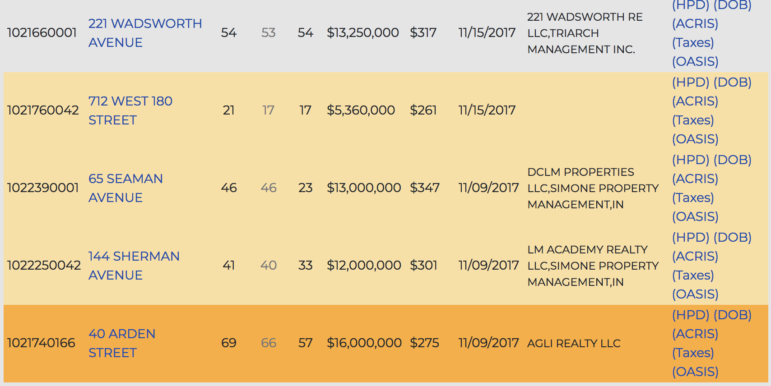
ANHD
From ANHD's District Report for Inwood, showing some of the rent-stabilized buildings sold in the past month.
On Thursday, the Association for Neighborhood and Housing Development released a new data tool to help stakeholders quantify the risks of displacement faced by tenants in rent-stabilized buildings. The reports are part of ANHD’s Displacement Alert Project (DAP), an ongoing mapping and data project to identify tenant displacement risk.
For each community district in the city, ANHD has produced a “District Report” that will be updated monthly and contain information about the number of rent-stabilized buildings that meet one of five criteria the organization sees as indicative of displacement pressures. The addresses of such buildings are also included, and a building is highlighted if it is flagged for multiple risk criteria.
One criteria is the sale of a rent-stabilized building within the last month, and ANHD notes that a high sales price can be evidence that the landlord hopes to displace tenants and replace them with higher-paying renters. Another criteria relates to the number of renovation permits filed by the landlord; in rent-stabilized buildings, certain types of renovations allow landlords to increase the rent.
Other criteria relate to reports of a high number of violations and complaints within the past month, which ANHD sees as a sign that the landlord may be trying to displace tenants through neglect.
Of course, a bad landlord with no intention to displace or a new owner taking over a troubled building would also show up under this metric. And, one might surmise, residents who are particularly active about filing complaints or receive higher levels of advocacy assistance might also register higher complaint numbers.
Here’s some observations we’ve made from the reports on the 12 neighborhoods where a rezoning is being considered, has already passed, or (in the case of Flushing) has been shelved.
Comparing just those 12 neighborhoods to each other:
• Manhattan Community District 12, where the Inwood zoning will soon be debated, had the highest number of rent-stabilized buildings sold in the past month (nine buildings for a total of $75 million); the highest number of buildings with more than five or more complaints filed with the Department of Housing Preservation and Development (188 buildings) and the highest number of buildings with 10 or more new violations issued by HPD last month (68 buildings).
• Bronx Community District 4, where the proposed Jerome Avenue rezoning is anchored, had the highest number of buildings with two or more complaints made to the Department of Buildings (17 buildings).
• Manhattan Community District 3, where the debate rolls on over whether to rezone only central Chinatown or some broader area, had the highest number of buildings applying for new DOB permit applications (36 buildings).









One thought on “Which Neighborhood Facing Rezoning Faces Steepest Displacement Risks?”
I wish I could upload the photo I took of my building’s front door, which is plastered with 8 or 10 notices. It’s 1795 Riverside drive in Inwood. This has been going on a long time. Is there no limit to how many MCIs there can be or how much the landlord charges? They charged us half a million dollars for doing next to nothing on the roof and DHCR goes along with it. The landlord has deregulated over a third of the building while in the J-51 program. HPD’s done an AWFUL job of spelling out tenants rights and providing a listing of the violation types. This needs to be a series of articles. And it would be great if you could interview city and state legislators to ask what they’re planning to do about it.
If anyone from Inwood is interested to keep up with current events regarding the rezoning, check out Inwood Preservation on Facebook.